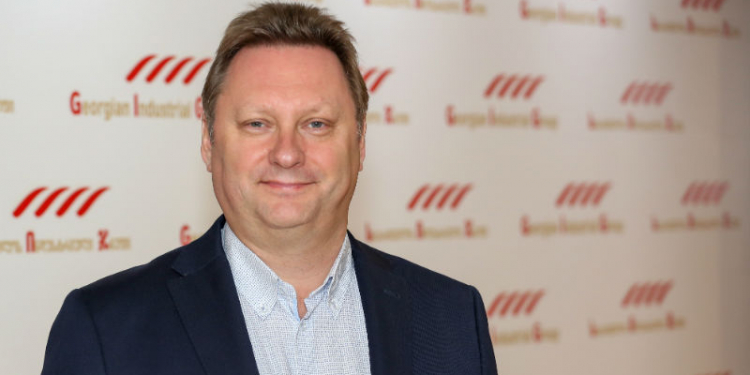The FINANCIAL — In response to increasing level of consumption, Georgian Industrial Group intends to construct a new 300 MW coal-fired power plant in Gardabani and commission it by the end of 2020, additionally, there are plans to construct sustainable energy power sources like hydro and wind, said Mr. Joerg Matthies, General Director of GIG, to The FINANCIAL.
Expectations and real results of 2016; prices of electro power; current and possible investments in the field; the growing amount of consumption and the country’s investing potential – these are the main topics that Mr. Matthies highlighted in his exclusive interview with The FINANCIAL.
Georgian Industrial Group is the largest industrial holding in Georgia with a diversified business portfolio, including coal mining, energy generation (hydro, natural gas and coal-fired power plants), natural gas retail and real estate.
Price of electricity is a painful matter for customers as well as producers, low prices absolutely discourage investors from putting money into the country.
“High prices for electricity are not necessarily bad for an economy, and even for the population, as they trigger out investments into energy saving measures thus reducing the demand for new capacity and eventually cutting the cost for the consumer,” Mr. Matthies told The FINANCIAL.
Despite the fact that the country is very interesting for investors and a large number of memorandums are signed for the construction of new power plants, not all of them materialize, according to GIG’s information. In order to realize as many projects as are planned, efforts need to be put into making future prices and sales more transparent, mentioned Mr. Matthies.
Q. What was your trade expectation for the following year and how do you see real results?
A. Judging by what was feasible this year we have done pretty well. We very much hope that next year will give new impetus to the regional electricity trade. A lot will depend on how things are going to evolve in the Turkish market. Other factors – rather unpredictable by nature – refer to the availability of water for hydropower generation. Despite the limits set for exchange volumes in the light of energy independence, we wish that incentives and conditions for transit deals in any near geographic direction will improve in the future.
Q. The price of electricity always remains a mutual problem for consumers as well as producers, especially during the current currency fluctuation. How do you evaluate the current price, and what are your expectations of it in the nearest future?
A. As with any other price, the price of electricity is a signal to investors on whether it is worth putting money into this kind of business. If the price is too low little money is spent on new projects and the rehabilitation of existing assets. We don’t think that the current level of electricity prices is too high and we assume that given the high demand for electricity in the years to come and the need to make new projects happen, an increase in price level shall be the ultimate result. At the same time, to take account of the time and demand factor there should be more of a differentiation of prices, for peak and base load for example.
High prices for electricity are not necessarily bad for an economy and even for the population as they trigger out investments into energy saving measures thus reducing the demand for new capacity and eventually cutting the cost for the consumer. In order to mitigate any potential adverse impact for those who are really in need of protection, special programmes will have to be adopted by the Government that are targeted directly at such groups of customers. However, that is an issue beyond electricity pricing which belongs to the area of social policy-making.
Q. Demand for electro resources are gradually growing – how do you respond to this pace of growth?
A. Indeed, electricity consumption in Georgia is growing steadily and will go up still further in the foreseeable future. Without increasing dependency on imports the only workable solution is to add new capacity both in thermal and hydroelectric facilities. Our response is exactly the same i.e. to get new generation capacity on stream.
Q. What are the ongoing projects as well as the ones which GIG is expected to launch in the nearest future?
A. In line with the general trend of increasing capacity needs it is our intention to construct a new 300 MW coal-fired power plant at the location Gardabani and to commission it by the end of 2020. Besides that, we also plan to construct renewable power facilities including hydro and wind.
Q. Which countries are the biggest partners in trade of GIG, what is the ratio for export in the trade, and what are their shares?
A. We have trading relations with all neighboring countries. Only hydroelectricity is available for export. Approximately 25% of our generated hydroelectricity was exported in 2016, with Armenia being the primary destination. We are also involved in importing electricity. GIG is a leading trader in the region and we intend to strengthen our position both in terms of volumes and outreach.
Q. Is the Georgian energy market attractive to investors? What makes the country interesting and what more can be done?
A. When looking at the large number of memorandums signed for the construction of new power plants we must conclude that there is a great interest in energy sector investments in Georgia. However, not all of them materialize. In order to bring as many projects as possible to fruition, it is important that there is absolute clarity about future pricing and sales.
A clear, transparent, stable and stimulating market model for renewable power is important as are the terms for thermal power. Otherwise the private sector will not take any risks and the state will have to fill the gaps, which in my opinion is something that should be avoided in a market-based economy. The process of EU association provides a unique opportunity to introduce positive changes in the energy market model, and the energy sector should be carefully listened to by politicians prior to adopting any amendments.
Q. Neogas, which is a subsidiary of Georgian Industrial Group, serves individual customers directly. What are the statistics connected to cars using gas instead of petroleum? How fast is the chain growing and is it meeting your expectations?
A. Indeed CNG is quite popular in Georgia and about 20% of vehicles are driven by gas. The future development mainly depends on how attractive gas will be in comparison to petrol and diesel. Restrictions on the registration and operation of highly polluting vehicles fueled by petrol and diesel can play an important role as well. Given the elevated pollution levels in cities such as Tbilisi, such restrictions should be enforced quickly.
Our chain has been growing steadily and now comprises 20 stations wholly owned or controlled by us. We plan to further expand and strengthen the position of Neogas as one of the three leading brands for CNG vehicle refueling in Georgia.
Q. During recent months special machines were installed in the mine for additional safety. Can you please specify what type of machines were bought and how safety measures have changed for miners?
A. We at GIG and our subsidiary Saknakhshiri take safety at work very seriously. Present and future development of the Tkibuli mines is based on introducing new equipment and technology. Not only will this increase productivity but likewise mechanization of underground mining processes inherently leads to considerably higher safety levels. This year we have purchased, for example, six underground electric railroad locomotives and one large roadheader machine. In addition, specific safety measures are taken which include, for example, the purchase of new gas masks. Next year we shall start implementing a new mine communication and alert system.
Q. One of the largest private-sector coal companies, Peabody Energy, stopped production because of the low level of demand on the market. What is the ongoing process on the world market in regard to coal mining and how can it affect GIG production?
A. Lately the international coal markets have picked up again. The prospects of coal mining in Georgia depend mainly on internal factors and only to a lesser degree on world market trends. With the construction of a coal-fired power plant with 300 MW of installed capacity and a long-term power purchase agreement with ESCO in place we are quite optimistic that coal output will considerably increase over the next 4-5 years to reach up to 1 m metric tons of raw coal. Apart from coal-fired power generation we also see good prospects in selling semi-coke and washed coal to various customers in Georgia.
Author Nikoloz Charkviani
































Discussion about this post